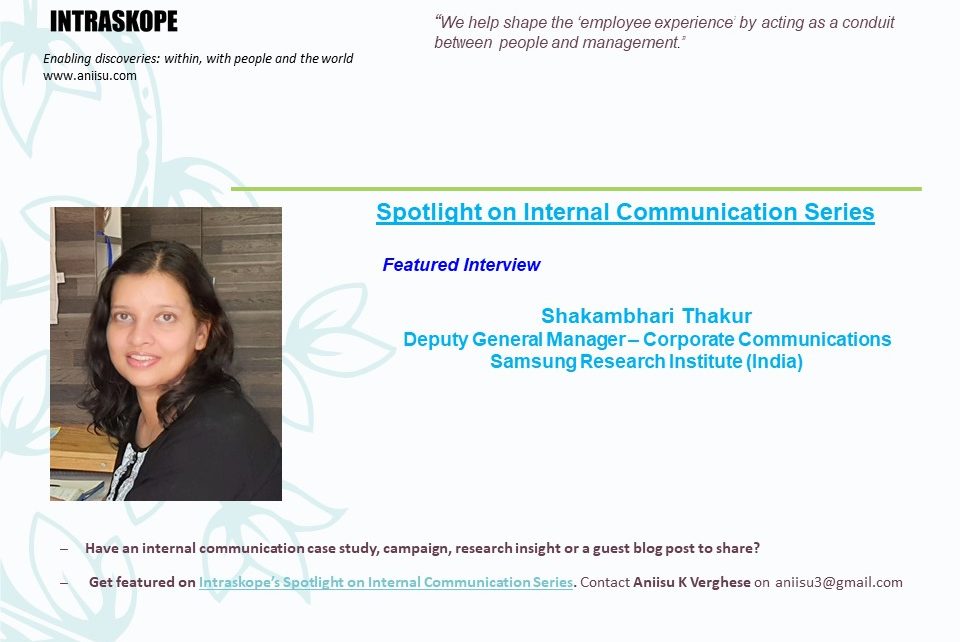Delighted to share the 33rd edition of Intraskope’s Spotlight on Internal Communication Series featuring Shakambhari Thakur. Watch the complete video interview on You Tube or read the transcript below. Shakambhari currently works as the Deputy General Manager: Corporate Communications – Samsung Research Institute at Bengaluru, India and has over 17 years of experience in corporate communications, CSR, brand management and public relations. She is a trusted adviser, storyteller with the specialty of launching communications function grounds up and helping organizations and its people craft their brand stories. Shakambhari and I have interacted as peers in the industry and in this interview, she shares an interesting campaign on personal branding for employees. Very glad she could share her thoughts on my blog.
Interview
1. What does internal communication mean to you?
Internal communications is a critical function which works in multiple directions but primarily in these two: 1) Voice of employees to the management and 2) The voice of management to the employees. Internal Comms. acts as the eyes, ears and mouthpiece of the organization as well as its people. We help shape the ‘employee experience’ by acting as a conduit between the people and the management. On the other hand, by becoming the medium through which management expresses their aspirations, learnings and expectations, internal communications eventually become critical in building the culture of the organization. Creating an ideal work culture where people feel motivated and management feels validated.
2. How is it practiced in your organization?
Internal communications is the backbone of our organization and a critical support function for a number of key stakeholders that cut across the org and all levels, ranging from business to support functions. Each stakeholder has their own unique requirements, so the internal communications team analyses the requirement, sets the expectation and produces deliverable to help each of them tell their stories better with effective landing of their message. From the employee experience perspective, we are constantly running campaigns and initiatives based on the pulse of employees through which our people can express their feelings, moments that matter openly thus providing an avenue to hone their communication and creative skills, as well as achieve a sense of transparency with management. With no two days being the same in our work, there’s never a dull moment.
3. Please share an example/campaign that you are personally proud of working on and that made a significant impact to an organization in the recent past
As managers, developing a great personal brand is crucial to enhancing your impact in the organization, whether it is creating a better rapport within your team or with other stakeholders. To help on this crucial aspect, we worked on a program for young managers to enhance BRAND ‘YOU’, through effective communication. This initiative drew learnings from Internal Communications and we learnt together about how these can apply at the team level and even with stakeholders. It was a pilot with a limited set of mid-level managers and proved to be a stupendous success mainly because of the openness of managers to unlearn, re-learn and discover new aspects about personal branding
4. What is the biggest challenge you face while going about managing internal communication?
One of the biggest challenges we face is a lack of communication with the communications team. Often and mostly towards the fag end of their own project, many stakeholders fail to take their own message seriously and leave it all to the comms team to figure out, assuming by default that they would be able to deliver the best. However, I feel, the owner should be best positioned to tell the essence of their message and should depend on comms to accentuate and improve their narrative. They need to be able to articulate their ideas better and have a clear picture of what it is that they want to say. Another challenge is getting employees to participate in an open, transparent and candid way. Even the best platforms can’t guarantee engagement if people aren’t forthcoming and directing them towards becoming more vocal and interactive can sometimes become a major challenge.
5. What according to you is the biggest opportunity that internal communicators have?
With fast eroding trust, evolving demography of the workforce and the pattern in which they consume content, internal communications is undergoing a sea change. People nowadays want better communication and transparency with their organization, and there are multiple ways and forms that companies around the world are adopting to achieve this. Internal communications is evolving rapidly and there is a need to transform and not just understand employees’ needs, but also align management to address them.
6. How can internal communicators add more value to the business?
While companies focus on doing what they do best like creating ground breaking technologies, they are completely dependent on communications team to showcase their stories whether internally or externally. When people see their work being talked about in the internal and external world, it instils a sense of pride and belongingness with the brand.
People being the company’s most valued asset and the foundation stone of most successful businesses, the best companies are focused on nurturing the “right people”. But it’s a two-way transaction, because people also want the “right experience” at the organization in order to truly commit, innovate and produce the best of their work. Internal communications is the facilitator in this interaction between the people and the brand, helping drive employee experiences in multiple ways through communication, motivation and inspiration. The major value-add here is the brand identity, a non-tangible yet definitive factor that helps nurture the right people and creates the best environment for professional success.
7. What skills must they have or develop?
The key skill that needs development is story-telling. Communicators need to know how to craft experiences into narratives that will engage an audience. They need to know what to say and how to say it. Another skill that almost goes without saying is learning how to be digitally savvy and agile as the corporate infrastructure is rapidly going digital. Even as we move towards experiences rather than mechanical task, soft skills (more like values) such as empathy and curiosity will go a long way in helping communicators.
8. What is your advice for people who are keen to join internal communication and make a career?
IC is an evergreen role and there is no better time than now to embark on a communications career. There is an increased awareness about the value IC brings to the table, and the emphasis is only likely to grow with time.
9. With COVID-19 and other crises, how must internal communications engage? What has changed or will change? Examples of how your organization has helped reassure employees and navigate the crisis as it unfolds.
When Edelman asked workers in ten countries what they considered the most credible source of information about the coronavirus, 63 percent of respondents said that they would believe information about the virus from their employer. Hence the need of the hour is lucid, frequent communication. Internal communicators need to reassure employees by providing the right information, explaining guidelines and best practices, creating awareness, constantly being in touch and showing empathy and support to ensure employees well-being as well as productivity at the same time. The most important message to convey right now is that #weareallinthistogether, so that we can all remain positive to build resilience during the chaos. In terms of long-term change, there was already a shift towards remote communications virtual employee engagement and adapting to the possibility of working from anywhere, and the COVID-19 pandemic seems to have accelerated this movement. As an organization we were proactive in our approach as we started with health screening in our premises as early as January itself and have been doing all of the above.
10. If there is one aspect of internal communications you would like to change, what would that be?
Often the value of what communications brings to the table is underrated, so there needs to be more awareness of what it is that internal communications is capable of and the demonstrable success it has already achieved. Another aspect is the possibility of moving from an ad-hoc and tactical mode of partnership with internal communications to something more strategic and well planned with buy in from key stakeholders within the organization.
_____________________________________________________________________________
Keen to contribute and participate in the ongoing series on Intraskope where we put the spotlight on thought leadership, great ideas, and practical solutions? Look up the previous stories from organizations featured on the Intraskope’s Spotlight on Internal Communication Series here – Falabella, Brillio, UAE Exchange, automobile major, Apeland, M.H. Alshaya Co, Proctor & Gamble, Infosys, SOBHA Ltd., ICICI Securities, First Advantage, CK Birla Group, TVS Motors, GE, Suzlon, Tata Sons, Percept, Knight Frank, TCS Europe, Vedanta, Oxfam, Danske Bank, Diageo, Pandora, Symantec, ISS Global Services, Telia, Thomson Reuters, IBM, General Motors, Intelligence India Software Solutions and Philips.
Intraskope (www.aniisu.com) is the first blog on internal communications in India and among the earliest around the globe. Begun in 2006, the blog has over 1000 posts on topics such as employee engagement, leadership communication and employee branding and receives thousands of visits from across the world. The blog, receives over 1,50,000 visits every month from over 50 countries globally, offers learning resources for practitioners, academicians, and students including industry workshops, research reports, and checklists. Intraskope has been featured on leading global internal communication forums like Simply-Communicate, IC Kollectif and International Association of Business Communicators. It is hosted by Aniisu K Verghese, author of Internal Communications – Insights, Practices & Models (Sage, 2012).
If you are an internal communication leader working in a firm or a not-for-profit anywhere in the world and have an internal communication case study, campaign, research insight or a guest blog post to share please contact me on [email protected]
Here are Internal Communications resources you can use:
• Internal Communications Series: https://forms.gle/KcqmPzLwq7NQi5Km6
• Chat with Aniisu – Internal Communications: https://www.instamojo.com/intraskope/connect-with-aniisu-60-minute-personalized-d/?ref=store
• Internal Communications workshops: https://bit.ly/2zdBRl1
You can also visit my website www.intraskope.com and You Tube channel to know more about my work.


